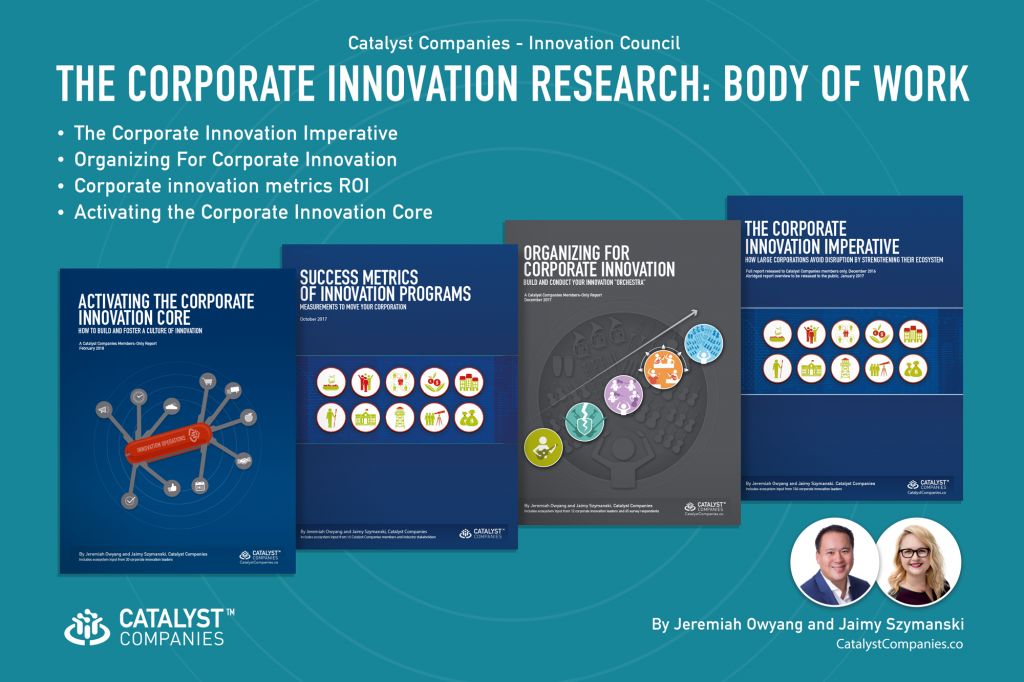
As part of my continued research stream on corporate innovation at Catalyst Companies, an Innovation Council, we’ve completed 3/4 research reports on how large companies are acting more like startups. Here’s some of the findings of how companies formalized innovation programs are shaping up. In this latest research effort, which I partnered with Jaimy Szymanski, looks at how companies are measuring their innovation efforts.
Success of Innovation Programs Depends on Metrics
We’ve identified the most common innovation programs in previous research. However, these programs – and innovation efforts themselves – will fail if metrics are assumed to be equal across all domains. Challenge: Early innovation efforts shouldn’t be measured by revenue –especially when compared to billion dollar product lines. So how should companies measure? Here’s what we found:
Fallacy: Revenue is King
At a high level the typical metric most often discussed at corporate is return on investment (ROI) or what shareholders prefer to hear, revenue. This mindset has, and will, condemn any formalized innovation efforts and undermine the success of innovation leaders themselves. Organizations with successful innovation programs reveal specific metrics for success – which may not include revenue, yet.
Recipe for Success
For any innovation program to mature it must have appropriate metrics aligned at the onset which will ultimately result in the organization’s goal of increased revenue in the long term. The metrics below were gained through qualitative analysis of Fortune 500 companies within the Catalyst Companies Council, as well as outside corporate executives, startup innovators and ecosystem experts.
Programs and their Success Metrics
- Dedicated Innovation Team
- Metrics are indistinguishable between these programs. Ideation is the key for these programs and should be accounted for accordingly.
- Amount of ideas generated to “top of funnel”, incubated, prototyped or meaningfully launched to market.
- Speed and efficiency for each of the aforementioned
- Return on marketing investment or product development expense
- Increase of customer satisfaction through specific metrics like NPS, testimonials or another identified metric
- Effectiveness of a new product or service through measurements like adoption, growth, retention etc
- Percent of leadership time spent on innovation vs daily operations.
Intrapreneur Program
Engagement is key for this program’s success. As such metrics should be assigned to measure overall involvement. Things like:
- Employee participation, trained or engaged
- Role or rank of participants
- Amount of workshops, training and attendance
- Amount of ideas submitted or generated
- Amount of ideas generated by innovation sponsors BU as compared to others
- Conversion rates of ideas
- ROI from ideas to market
- Efficiency of time to market
- Customer satisfaction
Open Innovation
Allowing external parties into corporate provides a symbiotic relationship which must be measured. Participating parties look to their benefits of things like potential funding or corporate support. Corporations must measure;
- Amount of ideas generated or participation through votes, comments or engagement
- Quality of start-ups participating in challenge/contest
- Amount of ideas that generate minimum viable product (MVP), measured per quarter
- Amount of ideas to production
- Efficiency from idea to MVP to production
- Development costs MVP or POC
- ROI and use of products resulting from challenge, contest or program
Metrics Tell Your Story and Prove Your Worth!
Aligning the innovation groups goals to corporate initiatives has never been more important. Revenue cannot be the only measurement, or the group and its leaders & personnel, will fail miserably. Identification of metrics at the start – including desired business outcome – will help determine which program is best suited for your organizational goals.
To learn more about this research, please send me an email at jko@cataylstcompanies.co
Very good article and insights, Jeremiah. I was wondering if you could provide some additional insights on industry benchmarks for some of these metrics. How do you determine what’s a good target for these metrics? Thanks.